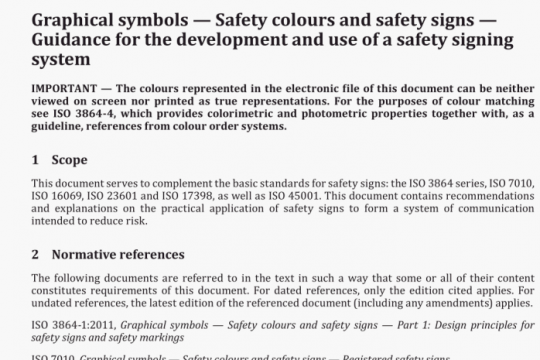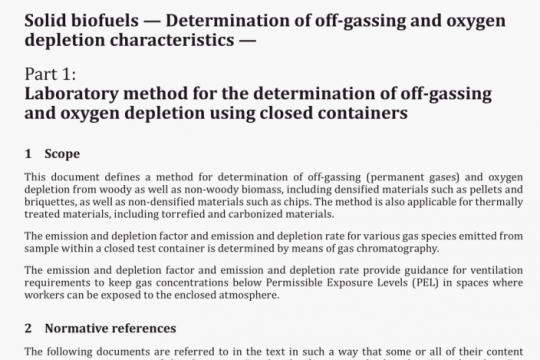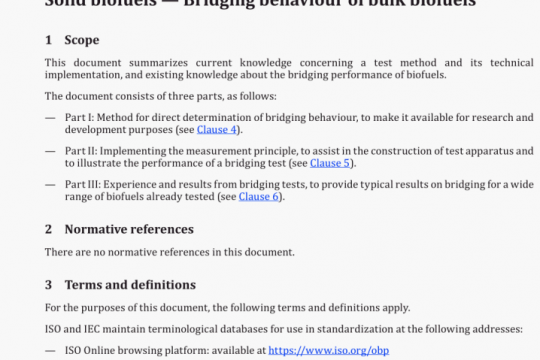ISO 19993 pdf free download
ISO 19993-2020 pdf free download.Timber structures – Glued laminated timber – Face and edge joint cleavage test.
This document specifies methods of evaluating the effectiveness of glued laminated timber face and edge bonds within a manufacturing plant by cleaving of the glue line in both dry and wet conditions. It is not intended that it be used for initial type testing where cyclic delamination or block shear is preferred. It is based on the principle that, provided minimum wood failure percentages are met, then the bond strength exceeds the perpendicular to the grain tension strength of the under-lying substrate and therefore the bond is not the weak element limiting the integrity of a glu lam assembly.
2 Normative references
There are no normative references in this document.
3 Terms and definitions
For the purposes of this document, the following terms and definitions apply.
ISO and IEC maintain terminological databases for use in standardization at the following addresses:
— ISO Online browsing platform: available at https://www.iso.orgJobp
— IEC Electropedia: available at http://www.electropedia.org/
3.1
wood failure
area of wood fibre remaining on the bond line following completion of the cleavage (12) test expressed as a percentage of the total test area excluding any areas of wood defect (gum vein and similar)
3.2
cleavage
rupture parallel to the wood grain of a glulam face or edge joint bond line or the adjacent adherend by the application of normal stress
4 PrInciple
A specimen consisting of a full cross-section of laminated timber is cleaved apart in the plane of the bond lines and wood failure is assessed after wet or dry conditioning.
Cleavage is achieved by cutting a saw ken that straddles the bond line then using a chisel, usually a bricklayer’s bolster, that is placed in the saw ken and is struck with a hammer to produce stresses perpendicular to the grain, in other words, to induce cleavage. II there is sufficient wood failure it means that the adhesive bond is stronger than that of the wood and that there is no loss of strength perpendicular to the grain at the interface between laminations.
5 Apparatus
5.1 ChIsel, with a wedge angle and thickness such that the tip of the blade does not touch the bottom of the saw cut of the test specimen before cleavage failure begins to occur; see Figure.2.
The width of the chisel shall exceed that of the specimen. NOTE A bricklayer’s bolster is a suitable implement.
5.2 Hammer or mallet, with a minimum mass of 1 kg.
5.3 Wood cutting equipment, such as a panel saw, band saw or circular saw.
5.4 Autoclave or similar vessel, designed to withstand safely a pressure of at least 500 kPa, equipped with a vacuum pump capable of drawing a vacuum of at least 65 kPa (500 mm of mercury) in the vessel and a pump or other device to provide a pressure of at least 500 kPa.
6 Preparation of test pieces
A member to be tested shall be manufactured to a slightly longer length than specified to allow for a representative specimen or specimens to be removed at the end of the member. The specimen(s) shall be removed from the off-cut portion at the end of the member after trimming to length. Each specimen shall be marked to identify the member from which it is cut.
The specimens shall include the full cross-section of the laminated timber to be tested, perpendicular to the grain of the wood and 50 mm long measured along the grain. Each bond line of the specimen shall be cut uniformly the full width of the specimen to a depth of 10 mm from one cross-cut face. For convenience, the specimen may be divided into smaller parts, provided the cuts are perpendicular to or well away from the bond lines and that all parts are tested (see Figure 1).ISO 19993 pdf download.




